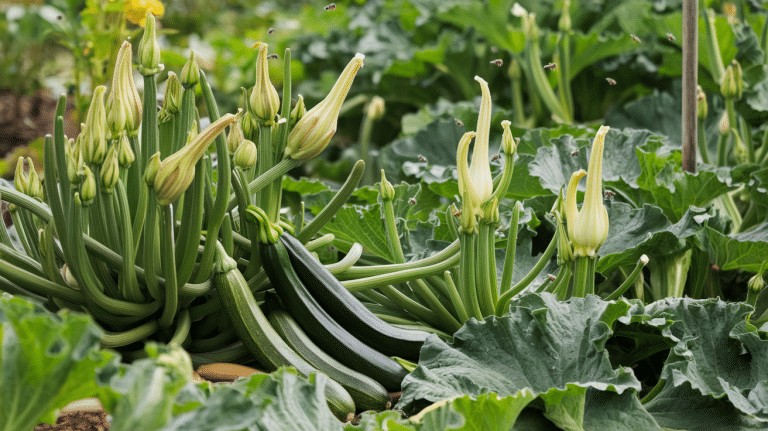Growing zucchini can be so easy—until suddenly, it’s not. You might have healthy plants with lots of flowers but end up with no zucchini to harvest. The secret often lies in pollination.
In nature, bees and other insects move pollen between zucchini flowers to make fruit grow. But sometimes, these helpers aren’t around when needed.
That’s when knowing how to hand pollinate becomes useful. This simple skill can be the difference between empty garden beds and baskets full of fresh zucchini all summer long.
This guide will show you how to help your zucchini plants produce fruit even when nature needs a boost.
When to Pollinate Zucchini
Knowing the right time to hand pollinate your zucchini plants can make a big difference in your harvest.
This simple process can help you grow more zucchini, especially when natural pollination isn’t happening as it should.
Best Time for Hand Pollination
For the best results, you should pollinate your zucchini early in the morning. This is when the flowers are fully open and ready for pollination.
Morning is also when pollen is most plentiful and active, which increases your chances of successful pollination.
The ideal time is typically between 6 AM and 10 AM, depending on your local climate. In hot areas, flowers might open earlier and close sooner to protect themselves from the heat.
Signs That Your Zucchini Needs Hand Pollination
You might need to step in and help pollinate your zucchini plants if you notice:
- Flowers are dropping off without forming any fruit
- Small zucchini starting to grow but then turning yellow, shriveling up, or rotting
- Not enough pollinators like bees visiting your garden
- An imbalance between male and female flowers, which often happens at the start of the growing season
Female flowers tend to appear first, but without male flowers present for pollination, they won’t develop into zucchini.
This timing mismatch is a common reason why early-season zucchini plants might not produce fruit right away.
Hand pollination is a quick fix for when natural pollination is failing. It can help your plants produce more zucchini.
Understanding Zucchini Flowers
What are Male and Female Zucchini Flowers?
Male zucchini flowers have a thin stem and a long stamen in the center that’s covered with yellow pollen. They grow on long, thin stems that connect directly to the main vine.
Female flowers look different. They have a small, fat zucchini-like swelling at the base (this is the future fruit). Inside the flower, they have a sticky center part called a stigma that needs pollen to make fruit grow.
You can tell them apart easily – if there’s a tiny zucchini at the base, it’s a female flower. No mini zucchini means it’s a male flower.
Why are Both Flowers Needed?
Male flowers make the pollen that must reach the female flowers for the zucchini to grow.
The pollen from the male flowers has to touch the center part of the female flower. When this happens, the small zucchini at the base of the female flower starts to grow bigger.
Without both types working together, you won’t get any zucchini. The male provides the pollen, and the female grows the fruit.
In nature, bees and other bugs carry pollen from male to female flowers. When not enough bugs visit your plants, you can help move the pollen yourself.
Most zucchini plants make more male flowers than female ones, especially early in the growing season. This is normal, but it means you need to watch for the female flowers when they open.
Step-by-Step Guide to Hand Pollinate Zucchini
Hand pollination is easy to do and takes just a few minutes each morning. This simple task can help your garden produce many more zucchinis.
Step 1: Identify Male and Female Flowers

Look for fully open flowers on your zucchini plant. Remember:
- Male flowers have a straight stem and no small zucchini at the base
- Female flowers have a tiny zucchini-shaped swelling at the base
- Only use flowers that are fully open – closed or wilted flowers won’t work
- Both types should have bright yellow petals when ready
Step 2: Harvest a Male Flower

To collect a male flower:
- Pick a fully opened male flower
- Hold the stem gently and snap or cut it
- Try to leave at least an inch of stem to use as a handle
- Don’t worry about taking male flowers – plants make plenty of them
Step 3: Transfer Pollen to the Female Flower

Now it’s time to pollinate:
- Remove the petals from the male flower to expose the pollen-covered center
- Gently touch or roll the male flower’s center against the center part of the female flower
- Make sure the yellow pollen sticks to the sticky center of the female flower
- Be gentle to avoid breaking the female flower
Step 4: Repetition (if necessary)

One male flower can pollinate several females:
- Use the same male flower to pollinate 3-5 female flowers
- Check your garden daily for new female flowers to pollinate
- Mark pollinated flowers by tying a small string to their stems
Tips for Success
Morning pollination works best:
- Pollinate between 6 AM and 10 AM when flowers are open wide
- Flowers often close by afternoon, especially in hot weather
- The pollen is most active in the morning hours
Helpful tools you can use:
- Small artist’s paintbrush to collect and transfer pollen
- A cotton swab or Q-tip works well too
- A small pair of scissors can help when cutting male flowers
Be careful with the flowers:
- Touch the centers gently to avoid damage
- Don’t pull too hard on any part of the flower
- If you break a female flower, don’t worry – new ones will open soon
Hand pollination is most helpful early in the growing season when there are fewer pollinating insects around.
Alternatives to Hand Pollination
Hand pollination works great, but it’s not the only way to get lots of zucchini. Let’s look at other options that might make growing zucchini easier for you.
Self-Pollinating Zucchini Varieties
Some zucchini types need less help with pollination:
- ‘Partenon F1‘ – a truly self-pollinating variety that makes fruit without pollination
- ‘Dunja F1‘ – known for making many female flowers early in the season
- ‘Gold Rush‘ – yellow zucchini that has good self-pollination abilities
- ‘Sure Thing‘ – made for container growing with strong self-pollination traits
These special varieties can make growing zucchini much easier, especially in places with few natural pollinators or for indoor growing.
Most garden centers and seed catalogs will tell you if a zucchini variety is self-pollinating or not. Look for this info when buying seeds or plants.
How to Attract Natural Pollinators
Making your garden friendly to bees and other helpers can solve pollination problems:
- Plant flowers that bees love near your zucchini (marigolds, sunflowers, borage)
- Avoid using bug sprays that can harm helpful insects
- Add a small dish of water with pebbles as a bee drinking station
- Grow herbs like basil, oregano, and thyme – they attract many pollinators
- Leave some patches of bare soil for ground-nesting bees
Morning is when most pollinating insects are active. If your garden has lots of bees in the morning, they’ll likely take care of pollination for you.
A mix of different flower colors and shapes attracts different types of pollinators. More types of pollinators mean better chances of zucchini pollination.
By growing the right zucchini types and making your garden friendly to helpful bugs, you might not need to hand-pollinate at all.
Advanced Tips for Pollinating Zucchini in Containers
Growing zucchini in small areas presents special challenges. However, with the right methods, you can still harvest plenty of zucchini from your pots and tiny garden spaces.
Container Growing Basics
Small-space zucchini needs extra attention. Use pots at least 18-24 inches wide and 12 inches deep. Fill with good-quality potting soil that drains well.
Place containers where they get 6-8 hours of sun daily. Water more often than in-ground plants since containers dry out faster.
Container zucchini often produce fewer male flowers. This makes hand pollination even more important for good results.
Pollinating in Limited Spaces
When space is tight, try growing two zucchini plants in separate containers placed close together. Choose bush varieties like ‘Patio Star’ or ‘Eight Ball’ that stay compact.
Hand pollinate every female flower – don’t skip any in small plantings. If you have only one plant, collect and store extra male flower pollen in the fridge.
Smaller spaces mean fewer natural bugs will find your plants, making your role as a hand-pollinator even more important.
Care Tips for Container Zucchini
Healthy plants produce more flowers to pollinate:
- Feed with liquid fertilizer every two weeks
- Check soil moisture daily, especially during hot weather
- Provide support for vining types to maximize limited space
- Watch out for pests – they can be more damaging to container plants
Adding a small pot of flowers, such as sweet alyssum or cosmos, next to your zucchini container can attract more helpful bugs.
Container-grown zucchini might produce less than garden plants, but with good pollination, you can still get a nice harvest from a small space.
Troubleshooting Zucchini Pollination
Growing zucchini can sometimes be tricky. Here are solutions to common pollination problems you might face in your garden.
No Male Flowers: What to Do?
Sometimes, you might see only female flowers on your zucchini plants. Don’t panic – try these solutions:
- Wait a few days – male flowers often show up later
- Ask a neighbor with zucchini plants if you can pick some male flowers
- Plant another zucchini variety nearby for cross-pollination
- Store male flower pollen in the fridge for 1-2 days in a paper bag
Male flowers typically appear in greater numbers as the season goes on. The plant often makes female flowers first, which can cause early-season problems.
Zucchini Flowers But No Fruit: Common Causes
Seeing lots of flowers but getting no zucchini? Here’s why this happens.
- Too few pollinators in your garden (bees, butterflies)
- Very high temperatures (above 90°F/32°C) can make pollen not work
- Poor plant health due to lack of water or nutrients
- Incomplete pollination – the pollen didn’t fully reach the female parts
Hot weather is a common reason for pollination failure. When it’s too hot, try to pollinate very early in the morning before the heat rises.
How to Encourage More Female Flowers
You can help your plants make more female flowers with these tips.
- Give your plants 8 hours of sunlight daily
- Keep soil moisture even – neither too wet nor too dry
- Add low-nitrogen, high-phosphorus fertilizer
- Maintain temperatures between 65-75°F (18-24°C) if possible
- Avoid over-feeding with nitrogen, which leads to more leaves and fewer flowers
Most zucchini plants naturally balance their flower production as they mature. A healthy plant will make both types of flowers throughout the season.
The right mix of sun, water, and care makes your plants much more likely to produce plenty of female flowers that turn into tasty zucchinis.
Conclusion
Hand pollinating zucchini is a simple skill that can greatly improve your garden results.
The process takes just minutes each day: spot the male and female flowers, transfer pollen with a gentle touch, and repeat as needed.
When you face problems like missing male flowers or no fruit forming, the tips in this guide will help you fix these common issues.
If you want an easier option, try growing self-pollinating zucchini or making your garden more friendly to bees and other helpful bugs.
Check out our other gardening guides for more expert tips. Have you tried hand-pollinating your zucchini? Let us know about your results in the comments below!













